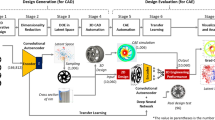Abstract
This paper describes the development of an intelligent system based on concurrent engineering for generating design alternatives at the conceptual design stage. The proposed system encompasses a design analysis module, a design evaluation module, a knowledge acquisition and storing module, a user interface and databases. It is also integrated with a spreadsheet application for storing data and numerical analysis and works in combination with a material selection software Cambridge engineering selector (CES) to facilitate the material selection process. The tangible advantage of implementing this system is that it enables the designer to explore and experiment with alternative ideas in the early design stage, and it results in design solutions that are functionally sound- and cost-effective. It also has the capability for design alternatives evaluation, material selection and modelling the product detailed design on the computer-aided design system. Therefore, an efficient product development process is generated. Three case studies are demonstrated and discussed to validate the proposed system.
Similar content being viewed by others
References
Abdalla HS (1999) Concurrent engineering for global manufacturing. Int J Prod Econ 60(1):251–260
Yung K, Ko S, Kwan F, Tam H, Lam C, Ng H, Lau K (2006) Application of function deployment model in decision making for new product development. Concurr Eng Res Appl 14(3):257–267
Lo CH, Tseng KC, Chu CH (2010) One-step QFD based 3D morphological charts for concept generation of product variant design. Expert Syst Appl 37(11):7351–7363
Chen CC, Chuang MC (2008) Integrating the Kano model into a robust design approach to enhance customer satisfaction with product design. Int J Prod Econ 114(2):667–681
Hung HF, Kao HP, Juang YS (2008) An integrated information system for product design planning. Exp Syst Appl 35(1–2):338–349
Shehab EM, Abdalla HS (2002) A design to cost system for innovative product development. Proc Inst Mech Eng Part B J Eng Manuf 216(7):999–1019
Sandberg M, Boart P, Larsson T (2005) Functional product life-cycle simulation model for cost estimation in conceptual design of jet engine components. Concurr Eng Res Appl 13(4):331–342
Takezawa A, Nishiwaki S, Izui K, Yoshimura M, Nishigaki H, Tsurumi Y (2005) Concurrent design and evaluation based on structural optimization using structural and function-oriented elements at the conceptual design phase. Concurr Eng Res Appl 13(1):29–42
Eynard B, Liénard S, Charles S, Odinot A (2005) Web-based collaborative engineering support system: applications in mechanical design and structural analysis. Concurr Eng Res Appl 13(2):145–153
Li T-S, Huang H-H (2009) Applying TRIZ and Fuzzy AHP to develop innovative design for automated manufacturing systems. Expert Syst Appl 364):8302–8312. doi:10.1016/j.eswa.2008.10.025
Zhang Z, Chu X (2009) A new integrated decision-making approach for design alternative selection for supporting complex product development. Int J Prod Comput Integr Manuf 22(3):179–198
Mascle C, Zhao HP (2008) Integrating environmental consciousness in product/process development based on life-cycle thinking. Int J Prod Econ 112(1):5–17. doi:10.1016/j.ijpe.2006.08.016
O’Flynn MJ, Ahmed M (1993) Computer-based concurrent engineering system. Concurrent engineering. contemporary issues and modern design tools Chapman & Hall, London, pp 184–206
Qiang L, Zhang Y, Nee A (2001) A distributive and collaborative concurrent product design system through the WWW/Internet. Int J Adv Manuf Technol 17(5):315–322
Islam M (2009) A dimensioning and tolerancing methodology for concurrent engineering applications I: problem representation. J Prod Adv Manuf Technol 42(9):910–921
Islam M (2009) A dimensioning and tolerancing methodology for concurrent engineering applications II: comprehensive solution strategy. Int J Adv Manuf Technol 42(9):922–939
Jong WR, Wu CH, Liu HH, Li MY (2009) A collaborative navigation system for concurrent mold design. Int J Adv Manuf Technol 40(3):215–225
Tseng KC, Abdalla H, Shehab EM (2008) A web-based integrated design system: its applications on conceptual design stage. Int J Adv Manuf Technol 35:1028–1040
Jiao J, Simpson TW, Siddique Z (2007) Product family design and platform-based product development: a state-of-the-art review. J Intell Manuf 18(1):5–29
Xu L, Li Z, Li S, Tang F (2007) A decision support system for product design in concurrent engineering. Decis Support Syst 42(4):2029–2042
Cross N (2009) Engineering design methods: strategies for product design, 4 edn. Wiley
Ulrich K, Tung K (1991) Fundamentals of product modularity. In: Sharon A (ed) Design/manufacturing integration, vol 39. ASME, New York, pp 73–79
Pahl G, Beitz W, Wallace K (1996) Engineering design: a systematic approach, 2nd edn. Springer Verlag, London
Author information
Authors and Affiliations
Corresponding author
Rights and permissions
About this article
Cite this article
Tseng, K.C., El-Ganzoury, W. An intelligent system based on concurrent engineering for innovative product design at the conceptual design stage. Int J Adv Manuf Technol 63, 421–447 (2012). https://doi.org/10.1007/s00170-012-3932-7
Received:
Accepted:
Published:
Issue Date:
DOI: https://doi.org/10.1007/s00170-012-3932-7




